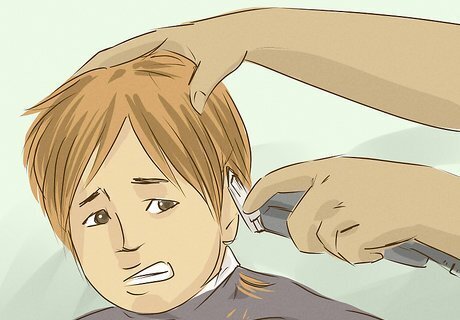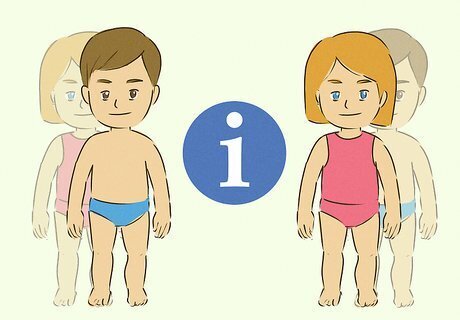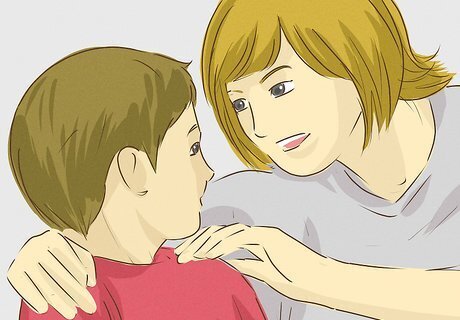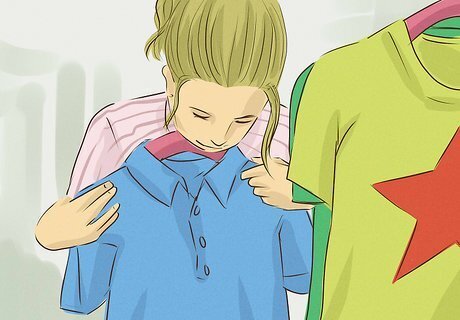
views
Observing Your Child

Notice if your child has gender non-conforming tendencies. Maybe you have seen that your daughter likes to play with toys that are generally considered masculine. Keep in mind that just because your daughter likes to play with trucks does not mean that she is transgender. However, if your child consistently displays a strong preference for things that don’t conform to gender expectations, it could be something to keep an eye on. A child who is different in a few ways might just be gender non-conforming. A child who is different in a lot of ways, and shows extreme unhappiness at being forced to act like the gender they were assigned at birth, is probably transgender. Remember, most notions of gender are stereotypes. Boys are not genetically predisposed to prefer the color blue, for instance. Some children like to dress up as characters of the opposite gender, or to cross-dress during imaginary play (for instance, a boy playing a princess or a girl putting on a play moustache). This on its own doesn't mean the child is trans, however, they may be trans if they only play as characters of a gender opposite to their assigned sex (for instance, if your child was assigned male but only dresses as female characters while playing dress-up and refuses to dress as male characters) or if they insist on dressing as a girl/boy even when not playing.

Look for signs along the way. A child who is transgender will usually show many signs of their true gender. Their imaginary play usually suggests their gender, as well as how they want to dress and groom themself. A child may be transgender if they show many of these signs: Insisting on shopping in the girls/boys section Choosing a masculine/feminine name for themself Preferring friends of another gender Becoming upset over haircuts, if they were born male Asking for shorter/more frequent haircuts, if they were born female Frequently pretending to be book or movie characters of another gender Hating their genitals Looking up to older people of the opposite gender and wanting to be just like them Begging for books or toys that say "for boys" or "for girls" Wanting to reincarnate as another gender Crying over the gender they were assigned at birth Being much happier when you let them do something related to the gender they express

Notice signs of unhappiness at being pushed into the wrong gender role. For example, if your "son" screams and screams over a haircut because she can't bear having short hair, or if your "daughter" cries when told that he can't get clothes from the boy's section, this is a sign that your child may be transgender. Gender is important, so your child may feel (and act) like the world is ending if they have to pretend to be someone they are not. Notice tantrums over haircuts, clothes shopping, wearing/not wearing the color pink/blue, and other decisions. It may feel like fighting your child to get them to conform to gender roles. Pay attention to arguing. For example, if you say "boys are allowed to wear dresses" and the child says "but I'm not a boy in a dress! I'm a girl!" then the child is probably transgender. Look for behavior problems, depression, and poor mental health. Children who are forced into the wrong gender role may be very upset and act out. They may also internalize negative feelings, which could lead to emotional trouble years later. Luckily, transitioning can usually fix most of this. Crying over haircuts could also indicate fear. Ask your child why they don't want their hair cut. If they say they're afraid, or that it might hurt, this is probably fear, but if they say they don't want their hair to be short, this might signify being trans.

Listen to how your child identifies. Your child might use different words to express themselves. If your child feels strongly about their gender, they might say things like, “I know I’m a boy!” even if they were assigned female at birth, or "No, I'm really a girl!" even if they were assigned male.

Recognize that gender develops young. Gender usually develops around age 3, but some children start earlier, as young as 2 years or 18 months.

Look for consistency. If your child insists on being called “John” for a weekend, that’s not necessarily an indication that the child is transgender. It’s also pretty typical for young kids to go through phases of pretending to be a different gender. If your child is really consistent in insisting they are actually a different gender, though, this could be a sign that they are transgender. A child who routinely insists upon their gender being different from their genitalia is very likely transgender. Transitioning can help the child's social development, focus in school, and emotional well-being, and may reduce behavior problems.

Recognize that some children may not understand their gender until puberty or later. Your child might not question their gender identity until they are a little older. Puberty is a common time for teens to begin questioning their gender identity. Changes in the body and in hormones can make your child become more aware of their discomfort. Puberty and the years after are common times for children to begin exploring. Listen to them if they begin to say that they feel they are another gender.

Do a trial run, if your child is interested. It can be really useful for your child if you allow them the freedom to really explore their gender identity. If your child thinks they are transgender, set aside a weekend or a couple of days and allow your child to present as another gender for a little while. This might mean, for example, that you call your child “Jennifer” and support their decision to wear a dress. Allow your child to lead in this experiment. Don’t pressure them to try things that they don’t want to try, such as being called by a different name. Watch your child during the trial run. Do they seem happier or more confident? Are they having more fun? This can help you tell whether this is what makes your child happy.

Allow your child to explore their gender identity with a therapist or counselor. Your child might not be fully comfortable discussing this with you, or you might feel like you aren’t really able to give your child the full support they need. Try finding them a counselor or therapist to work with. Look for a licensed professional who has experience in working with transgender children.
Understanding What Transgender Means

Understand the meaning of “transgender." The meaning is often debated, and the term has evolved a lot. A common consensus says that transgender means someone has a gender identity that is different from their assigned sex. When learning about bodily anatomy, you can teach that a biological boy has a penis and a biological girl has a vulva, but this does not hold true for someone with a transgender identity.

Learn about what makes a child transgender. Being transgender is not a choice that your child is making. It also has nothing to do with how you have raised them. It is typical for parents to say, “What did I do to cause this?” The answer is “nothing.” Transgender children are born that way. Know that being transgender is not “abnormal.” It is a documented medical condition for a child to be born transgender. If this is the case for your child, the emphasis should be on supporting the child. Don't get caught up in worrying about what is "normal."

Recognize that some people take longer to recognize and express their gender than others. While some children are loudly declaring their true gender at age 3, some take longer to figure out that they're trying to live as the wrong gender. Here are some things that can delay the coming-out process: Lack of knowledge Fear of rejection Witnessing stigma Having tried to express themselves, but been teased or scolded

Read reliable sources. Don’t listen to myths or rumors. Take the time to really investigate what it means to be transgender. Check out sources like the PFLAG website or the Family Acceptance Project. You could also head to the local library. Ask the reference librarian to recommend some good books on being transgender. Read stories from transgender people. These first-hand accounts can help you understand what it feels like to be transgender.

Recognize the difference between a phase and being transgender. If your child consistently insists on their gender, then it is very, very likely not to be a phase. If your child thinks it might have been just a phase, talk about it before leaping into action. A child who says it was "just a phase" may be lying because they are being mistreated, or they think you'll love them less if they are transgender. Ensure that they know that you love them either way, and that they are serious about this.

Talk to a medical professional. If you have questions about the science of being transgender, talk to your child’s doctor. If you are wondering about the psychological impact, consult a therapist. Remember, this is a confusing time for you as a parent, too. You might want to consider getting some outside support by seeing a counselor to help you process your child exploring their gender identity. Professionals are usually very thoughtful and will not rush your child into something that they are not ready for. Keep in mind that just because you don't feel ready doesn't mean that your child isn't ready, or that your child isn't hurting by waiting for you to catch up.
Helping Your Child Feel Comfortable

Follow your child's lead. If you listen well, your child will tell you what they want for themselves. This can help you tell the difference between a child who says "I'm a girl" and a little boy who just likes wearing dresses. The choice to transition (or not) should be based on your child's needs and happiness, not on what you think your child should be. Don't stop a child from being themselves because you aren't comfortable with it. Explain to your child that there are certain social and biological limitations to changing one's sex. A girl who transitions to a boy will not be able to pee in a urinal without a specific device or surgery later in life. It is not currently possible for a boy who transitions to a girl to ever experience menstruation or physically give birth to a child. Many transgender people have gotten through childhood normally and have then decided to transition as an adult when they were more fully aware of the scope of their options.

Recognize that your support makes a huge difference in your child's future. Transgender children with supportive families are much less likely to attempt suicide, become homeless, or face serious mental health issues. A supportive family can also help a child deal with issues like bullying and discrimination, lessening the harm to the child's mental health. By accepting and supporting your child's gender, you are help keeping them safe from the many issues that can plague transgender people. Studies show that transgender children who have transitioned have equal rates of depression to their cisgender peers, and only slightly higher rates of anxiety. On the contrary, those who are transgender but do not transition have very high rates of mental health issues.

Be supportive of your child. If your child expresses changes in their gender identity, try not to react negatively. Don’t criticize them or tell them that you don’t want to hear it. Instead, allow your child to explore their identity by trying new activities or dressing differently. If you have concerns, talk to your partner or your child’s doctor. Don’t tell your child about your concerns. Love your child for who they are. You child might be going through a difficult time. Make sure to let them know that you love them unconditionally. It can help to say things like “I know you’re going through some changes. Just remember, I love you no matter what.” Remind your child that they're safe, and that they're free to be themselves wherever they are.

Stand up for your child. If your child is going outside of gender normative behavior, they might be teased or bullied. For example, other kids might taunt your son if he starts transitioning by dressing like a typical boy. Help your child address the issue. Let them know that you will speak to the teacher or the parents of the other children on their behalf. If you hear someone make a negative comment about transgender people, say something along the lines of “Comments like that are not okay. Please don’t say that again.” Think about if you'd be okay with that person saying such a comment to your kid.

Support social transitioning. Social transitioning means that your child might choose to live as another gender. Make an effort to get behind their decisions. If your child wants to dress differently, let them. If they want to be called by another name, that is their choice, and you should listen and cooperate. Recognize that social transitioning is completely reversible. If it turns out to be a phase, then your child can change their hair back and change their wardrobe. And your child will remember that you supported them while they were questioning, which will mean a lot to them. Don't panic over social transitioning. While some parents have a hard time with the idea at first, remember that this is important to your child, and that it can always be reversed if it turns out that your child isn't happier this way.

Be on the lookout for signs of depression or anxiety. Transgender kids might feel a lot of pressure, and can endure bullying, discrimination, and lack of acceptance from community or even family members. This can take a toll on the child. If you notice signs of a problem, take your child to a mental health professional. Be on the lookout for: Excessive sleeping or sleep loss Sudden weight loss or gain Lack of interest in activities they previously enjoyed Noticeable mood shifts

Explore future medical options if your child is transgender. Your child might want to take steps towards feeling more comfortable in their body. Medical options are meant to support your child, not to "cure" being transgender. Talk to your child’s doctor about whether these options are right for them. For young teens, puberty blockers can stop them from the trauma of going through the wrong puberty. These only delay puberty, and are completely reversible. This is the best "neutral option," and it can help reduce mental health risks. As an older teen or adult, your child may start taking hormones to help them go through the puberty that is right for their gender. As an adult, they might choose to have gender confirmation surgery. Some need this, while others are okay without it.




















Comments
0 comment